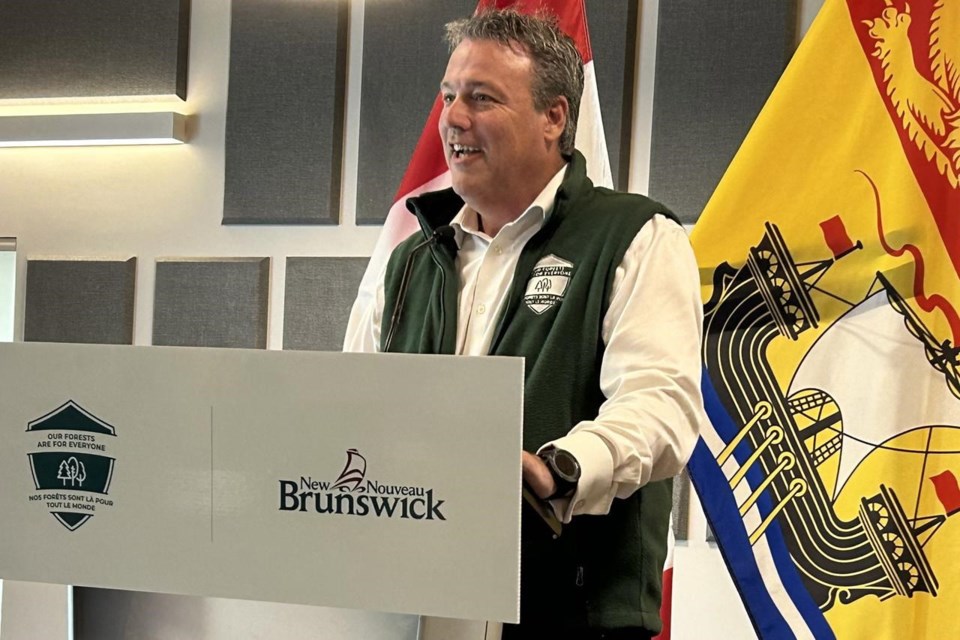FREDERICTON ŌĆö For the first time, the New Brunswick government is considering the risks of climate change in its long-term forest-management strategy, but critics say the province's interests are still too weighted in favour of industry over environment.
The new forestry plan, presented Wednesday by Natural Resources Minister Mike Holland, promises to restore the area of Crown land set aside for conservation to 30 per cent from 23 per cent, as it was about a decade ago. The province is also looking to extract more out of forests, including by increasing maple syrup production and advancing the interests of private woodlot owners.
But Holland said that, for the first time, the government is also considering the effects of climate change on an industry that generates $2.8 billion per year in forestry export products, and contributes $1.5 billion annually to the province's economy.
"In years gone, building and growing the industry sector has been the primary focus of government," Holland told reporters.
"Today's strategy, and for the first time ever, takes multiple and different uses other than forestry into consideration.ŌĆØ
Climate change, he said, is expected to accelerate the decline of balsam fir. In response, the province will plant a mixture of other softwoods to take its place, such as white, black, and red spruce, along with smaller amounts of white, red, and jack pine.
Holland said climate change will present surprises. "I think we're going to see the future show us a whole lot of things that we just expected were always going to be the same way, have to change," he said.
"Coniferous species in general, boreal forest type of species, that range is getting further and further north all the time. In 100 years, we're going to see a different landscape for sure. We need to start now to protect and be ready for it."
Roberta Clowater, executive director of the New Brunswick chapter of the Canadian Parks and Wilderness Society, said she was encouraged by the general direction of the government's forest-management strategy, especially with regard to a rise in the amount of land set aside for conservation.
"There are things that are still missing. We still have quite a focus on clear-cutting. We still have quite a focus on herbicides and spraying and plantations as a way of bolstering the industrial side of the forest strategy," she said.┬Ā
"I think that there are glimmers of elements that can allow us to do more ecological forestry into the future, if we keep on this path and show that you can still have lots of good jobs."
Her organization has been calling for making climate change more of a focus of forest management, she said. "The fact that it's finally getting in there is positive."
MiŌĆÖkmaq chiefs in New Brunswick say the strategy was created without the "full" involvement of First Nations. The government ignored First Nations' proposals, said a statement from MiŌĆÖgmaweŌĆÖl TpluŌĆÖtaqnn Inc., an organization that represents eight MiŌĆÖkmaq communities in New Brunswick.┬Ā
"Instead, they engaged in an inadequate 'consultation' process where they claimed that forestry, the single biggest industrial activity on our lands and waters, has only a moderate impact on our rights," the group said.┬Ā
"They unilaterally proposed an accommodation package that did not meaningfully address our concerns, and refused to consider negotiating any changes to it. In particular, they ruled out a shared decision-making structure, without providing any reasons for doing so."
Green Party Leader David Coon applauded the government for restoring conservation land from 23 per cent to 30 per cent, but he said the overall strategy will lead to a loss of forest diversity.
"(Holland) managed to go back to the status quo to restore the area of forest to 30 per cent on Crown lands that had conservation objectives that existed between 2008 and 2014 and then disappeared and was reduced to 23 per cent under the former Conservative government. He's restored that to what was the status quo for many years," he said. "So, that's a win."
However, he said he would like to see the government plant more hardwood trees, such as oaks and maples, rather than pines and spruces to replace balsam fir.
Spruces await a similar fate as balsam firs in light of climate change, such as disease, degradation, decline and die off, Coon said, adding that industry came out on top with the government increasing plantation of spruces and pines that will feed timber and sawmills.
"What you lose is biodiversity. What you lose is valuable wildlife habitat," Coon said. "What you lose is the kind of resiliency that a more diverse natural forest provides."
This report by The Canadian Press was first published Aug. 30, 2023.
Hina Alam, The Canadian Press



